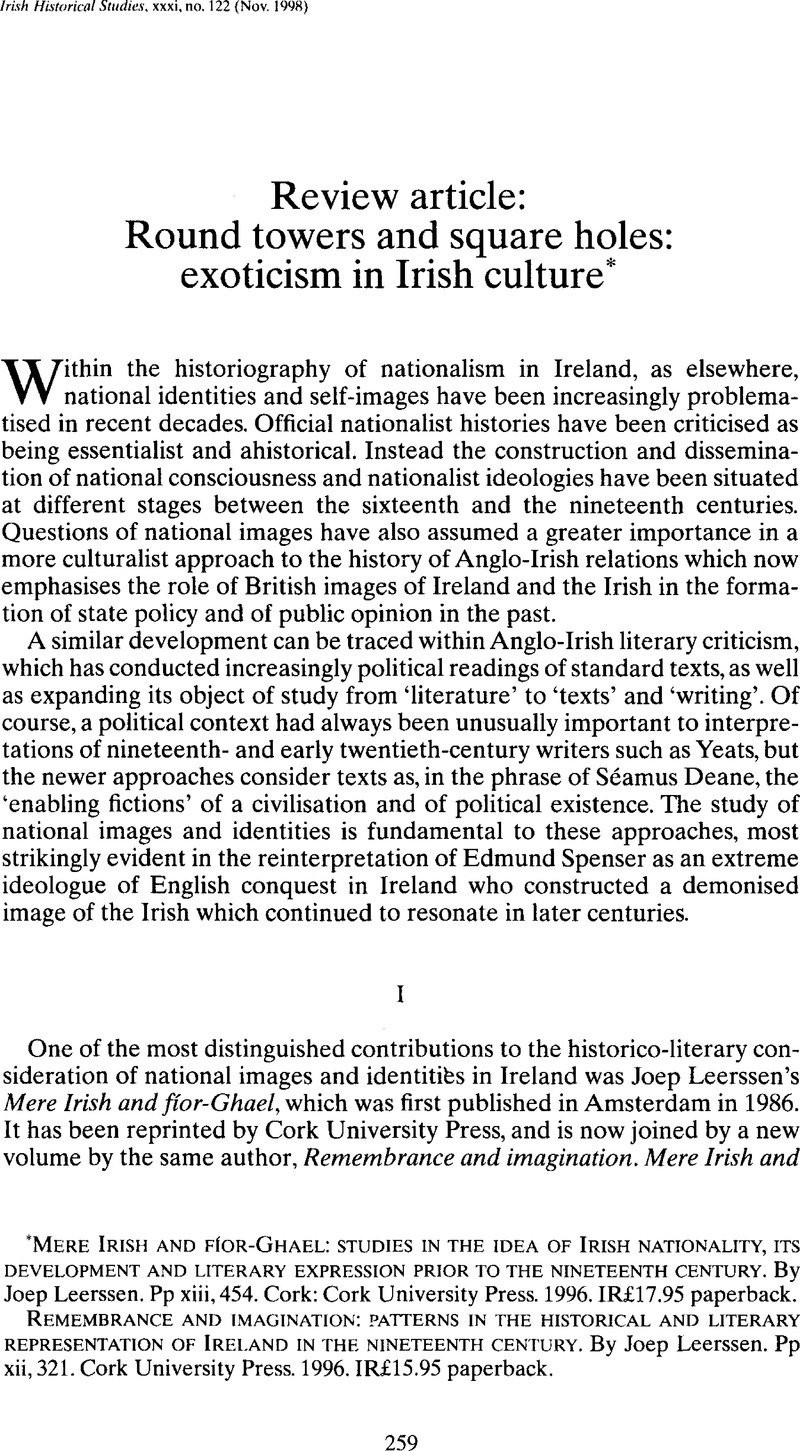No CrossRef data available.
Article contents
Round towers and square holes: exoticism in Irish culture*
Published online by Cambridge University Press: 21 March 2016
Abstract

- Type
- Review articles
- Information
- Copyright
- Copyright © Irish Historical Studies Publications Ltd 1998
Footnotes
Mere Irish and fíor-Ghael: studies in the idea of Irish nationality, its development and literary expression prior to the nineteenth century. by Joep Leerssen. Pp xiii, 454. Cork: Cork University Press. 1996. IR£17.95 paperback.
Remembrance and imagination: patterns in the historical and literary representation of Ireland in the nineteenth century. By Joep Leerssen. Pp xii, 321. Cork University Press. 1996. IR£15.95 paperback.
References
1 Most of these were acknowledged by Leerssen: Quinn, D.B., The Elizabethans and the Irish (Ithaca, 1966)Google Scholar; Canny, Nicholas, The Elizabethan conquest of Ireland: a pattern established, 1565–76 (Hassocks, 1976)Google Scholar; Curtis, L. P. jr, Anglo-Saxons and Celts: a study of anti-Irish prejudice in Victorian England(New York & Bridgeport, Conn., 1968)Google Scholar; Lebow, Ned, ‘British historians and Irish history’ in Eire-Ireland, viii, no. 4 (1973), pp 3–38 Google Scholar; Deane, Séamus, Civilians and barbarians (Derry, 1983)Google Scholar; Duggan, George, The stage Irishman: a history of the Irish play and stage character from the earliest times (London, 1937)Google Scholar; Bartley, J.O., Teague, Shenkin and Sawney (Cork, 1954)Google Scholar; Bradshaw, Brendan, ‘Native reaction to the Westward Enterprise: a case-study in Gaelic ideology’ in Andrews, K. R. et al. (eds), The Westward Enterprise: English activities in Ireland, the Atlantic and America, 1480–1650 (Liverpool, 1978), pp 65–80 Google Scholar; Dunne, Tom, ‘The Gaelic response to conquest and colonisation: the evidence of the poetry’ in Studia Hib., xx (1980), pp 7–30 Google Scholar.
2 Leerssen, Mere Irish & fíor-Ghael, p. 79.
3 Leerssen, Remembrance & imagination, p. 6.
4 Ibid., pp 37–8.
5 Foster, J.W., Fictions of the Irish literary revival: a changeling art (Dublin, 1987), ch. 6Google Scholar; Nash, Catherine, ‘ “Embodying the nation”: the west of Ireland and Irish identity’ in O’Connor, Barbara and Cronin, Michael (eds), Tourism in Ireland: a critical analysis (Cork, 1993), pp 86–114 Google Scholar.
6 Leerssen, Remembrance & imagination, p. 4.
7 Cronin, Michael, Translating Ireland: translation, languages, culture (Cork, 1996), p. 144 Google Scholar; Earls, Brian, ‘Mere Irish and fíor-Ghael’ in Revue Belge de Philologie et d’Histoire, lxviii (1990), pp 739-51CrossRefGoogle Scholar.
8 Leerssen, Remembrance & imagination, p. 277.
9 Ibid., p. 119.
10 Flanagan, Thomas, The Irish novelists, 1800–1850 (New York, 1959)Google Scholar; Eagleton, Terry, ‘Form and ideology in the Anglo-Irish novel’ in his Heathcliff and the Great Hunger: studies in Irish culture (London, 1995), pp 145–225 Google Scholar.
11 Leerssen, Remembrance & imagination, p. 38.
12 Ibid., p. 277 n. 53. It would, of course, be more consistent, in a book which deals with representation and imagination, to treat such Malthusianism not as straightforwardly referential but as itself a representation or imagining of Ireland. It occurs in this way in some of the other texts discussed in Remembrance and imagination, though not noted by Leerssen, such as John O’Donovan’s Ordnance Survey Letters — e.g. from Donegal, 15 Oct. 1835. There are some revealing examples of just such a Malthusian imagination among Irish observers in the 1830s, both élite and non-élite, in Drake, Michael, ‘Marriage and population growth in Ireland, 1750–1845’ in Econ. Hist. Rev., 2nd ser., xvi (1963), p. 302Google Scholar.
13 Leerssen, Remembrance & imagination, p. 147.
14 Ibid., pp 2–3.
15 Ibid., p. 164.
16 Ibid., p.2.
17 Ibid., p. 5.
18 Brown, Malcolm, Sir Samuel Ferguson (Lewisburg, Pa., 1973), ch. 5Google Scholar; Cairns, David and Richards, Shaun, Writing Ireland: colonialism, nationalism and culture (Manchester, 1988), ch. 2Google Scholar; Deane, Séamus, A short history of Irish literature (London, 1986), pp 67–71 Google Scholar.
19 Mercier, Vivian, Modern Irish literature: sources and founders (Oxford, 1994), p. 74 Google Scholar.
20 Leerssen, Remembrance & imagination, p. 157.
21 Ibid., p. 160.
22 Connolly, S.J., Priests and people in pre-Famine Ireland, 1780–1845 (Dublin, 1982)Google Scholar; Inglis, Tom, Moral monopoly: the rise and fall of the Catholic church in modern Ireland (Dublin, 1996), chs 6–7Google Scholar; Earls, Brian, ‘Legends of the supernatural in Anglo-Irish literature’ in Béaloideas, lx (1992), p. 96 Google Scholar.
23 The agrarian societies tend in this writing to become the standard-bearers of some form of counter-hegemony, whether conservative or radical, although little is known for certain about their ideology. See, for example, Gibbons, Luke, ‘Topographies of terror: Killarney and the politics of the sublime’ in South Atlantic Quarterly, xcv (1996), pp 23–44 Google Scholar; idem, ‘Between Captain Rock and a hard place: art and agrarian insurgency’ in Foley, Tadhg and Ryder, Seán (eds), Ideology and Ireland in the nineteenth century (Dublin, 1998), pp 23–44 Google Scholar; Lloyd, David, ‘Violence and the constitution of the novel’ in his Anomalous states: Irish writing and the post-colonial moment (Dublin, 1993), pp 125-62Google Scholar.
24 Morash, Chris, Writing the Irish Famine (Oxford, 1995)CrossRefGoogle Scholar; Ryder, Seán: ‘Reading lessons: famine and the Nation’ in Morash, Chris and Hayes, Richard (eds), Fearful realities: new perspectives on the Famine (Dublin, 1996), pp 151-63Google Scholar.
25 Leerssen, Remembrance & imagination, pp 161, 79.
26 Ibid., p.221.
27 Ibid., pp 205–7.
28 Ibid., p.231.
29 Colley, Linda, Britons: forging the nation, 1707–1837 (London, 1992).Google Scholar
30 Leerssen, Remembrance & imagination,p. 161.
31 Mason, W. S. (ed.), A statistical account, or parochial survey of Ireland (3 vols, Dublin, 1814-19)Google Scholar.
32 Wilde, William, ‘Report upon the tables of deaths’ in Report of the commissioners appointed to take the census of Ireland for the year 1841, pt 3, p. iii Google Scholar [504], H.C. 1843, xxiv, 591.
33 Ibid., ppiii-v, 591–3.
34 Ibid., pp vi-ix, 594–7.




